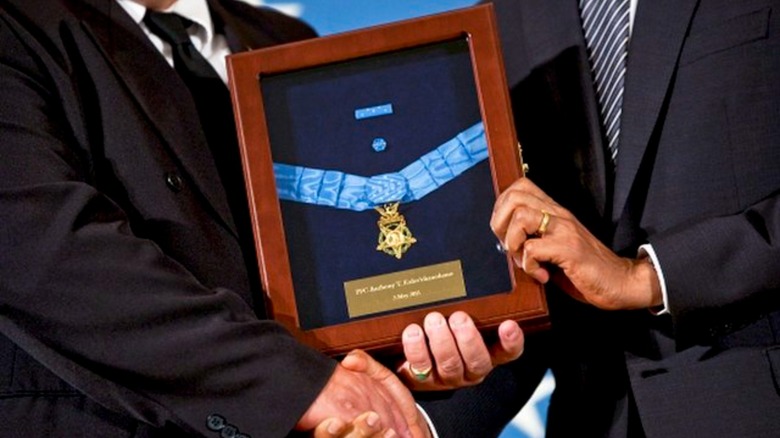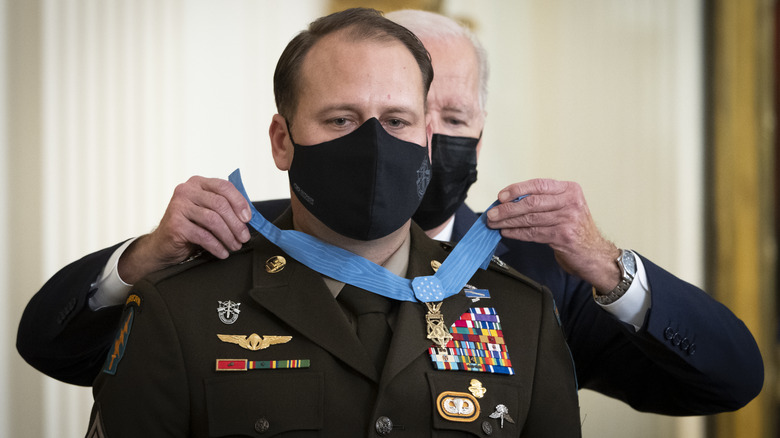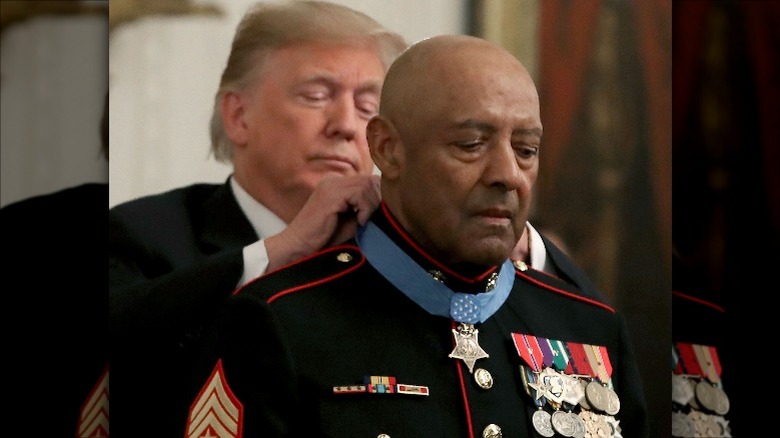These Are The Criteria For Being Awarded The Medal Of Honor
There is no higher accolade awarded in the United States Armed Forces than the Medal of Honor, which is awarded to military personnel serving across the Army, Navy, Air Force, Marines, and Coast Guard for incredible acts of valor and selflessness.
Or, in the exact words of the Joint Resolution of Congress, 12 July 1862, through which the award is defined, for "gallantry and intrepidity at the risk of his life above and beyond the call of duty while engaged in an action against an enemy of the United States; while engaged in military operations involving conflict with an opposing foreign force; or while serving with friendly foreign forces engaged in an armed conflict against an opposing armed force in which the United States is not a belligerent party" (via govinfo).
But while the bravery of U.S. military personnel is in no doubt, the chances of receiving a Medal of Honor are incredibly remote. While the Congressional Medal of Honor Society reports that, at the time of writing, just over 3,500 of the medals have been awarded since it was first established way back in 1861 — that's a rate of around 22 a year — just 30 have been awarded for actions undertaken since the end of the Vietnam War in 1975.
'Conspicuous gallantry'
The Resolution (via govinfo) makes clear that the gallantry in question must involve the person in question putting their life on the line in circumstances so exceptional that they are "conspicuous" in having excelled in the field above even their closest colleagues. An example of the kind of conduct that goes above and beyond the call of duty is provided by the official U.S. Army website, which carries the official citation of Cpl. Alvin C. York, who during World War I fought valiantly against German forces in France, on Oct. 8, 1918. His citation reads: "After his platoon had suffered heavy casualties and three other noncommissioned officers had become casualties, Cpl. York assumed command. Fearlessly leading seven men, he charged with great daring toward a machine gun nest, which was pouring deadly and incessant fire upon his platoon. In this heroic feat the machine gun nest was taken, together with four officers and 128 men and several guns."
But the rarity of receiving a Medal of Honor is also increased by the fact that the Resolution stipulates that there must be irrefutable proof that the deeds in question took place, while the process that allows military personnel to have their valorous deeds honored in a special ceremony at the White House is long and arduous.
Providing proof
If a person in the military is deemed to have shown gallantry, bravery, and self-sacrifice above and beyond the call of duty, for their actions to be found deserving of such high reward as the receipt of the Medal of Honor — as well as its many monetary benefits, which include a higher pension package than ex-military personnel otherwise receive — they must provide abundant proof to validate their claims.
As the Congressional Medal of Honor Society details, any citation for the Medal of Honor — typically made by a nominee's immediate superior — must be accompanied by reports that extensively detail the exact actions of the said person and the setting in which those actions took place. Not only that, but they must be corroborated by at least two eyewitness statements collected from colleagues, and the citation must also include any other evidence to offer the greatest possible proof of the person in question's valiant actions.
The citation and all accompanying evidence is then submitted up the chain of command, all the way up to the President of the United States, who makes the final decision. Citations must be submitted within three years of the said gallantry, while personnel who are deemed worthy of the award are presented with the Medal of Honor by the President personally within five years.


